Discovering hail damage on your roof doesn’t have to be a homeowner’s worst nightmare. With the right knowledge and approach, identifying and addressing this common issue can be straightforward and stress-free. Let’s dive into the essentials of hail damage roof repair, ensuring your home remains a safe haven, no matter the weather.
Understanding the Impact of Hail on Your Roof
When a hailstorm hits, your roof is the frontline defender, shielding you from the elements. The thing about hail is that it doesn’t discriminate—whether your roof is new or old, hail can cause significant damage. Often, the damage isn’t just cosmetic but can affect the structural integrity of your roof, leading to leaks and other issues down the line.
Initial Steps: How to Properly Inspect Your Roof for Hail Damage
The first step in addressing hail damage is a thorough inspection. Start by checking your gutters and downspouts; are they full of shingle granules? This could be a sign that your shingles have been compromised. Don’t forget to look for dents on your siding, gutters, or even the air conditioner unit, as these can also indicate hail impact.
Safety first—use a ladder securely and, if possible, inspect your roof from ground level with binoculars. Better yet, consider hiring a professional to conduct the inspection if you suspect damage or if accessing your roof safely is not possible.
Key Signs of Hail Damage to Look Out For
Spotting hail damage involves looking for specific signs. Look out for bruised shingles, which may have small dents where hail hit. Cracked or broken shingles are another telltale sign. Hail can also strip away the protective granules from the surface of shingles, exposing the underlying material to the elements.
DIY Repair Tips for Minor Hail Damage on Your Roof
Minor hail damage might be something you can tackle yourself. Start by replacing damaged or missing shingles to prevent water from seeping into your home. Asphalt shingle repair kits are available at most home improvement stores and can be a quick fix for minor issues. However, ensure you’re comfortable and safe working on your roof; otherwise, professional help is just a call away.
When to Call the Professionals for Roof Hail Damage Repair
If after your inspection, you’re facing extensive damage, it’s time to call in the professionals. Look for certified roofing contractors with experience in hail damage repairs. They will provide a comprehensive assessment and create a repair plan suited to your needs.
Professional roofers not only repair the visible damage but can also assess and fix any structural damage that may not be immediately obvious. Remember, the goal is not just to repair your roof but to ensure it’s equipped to protect your home against future hailstorms.
Navigating Insurance Claims for Hail Damage Repairs
Dealing with insurance can be the most challenging part of the repair process. Start by reviewing your policy to understand your coverage, then document the damage with photos and notes. An insurance adjuster will inspect the damage to determine the claim amount. Remember, having a professional roofer present during the adjuster’s visit can help ensure all damage is accounted for.
Finally, be patient but persistent. Insurance claims for hail damage can take time, and negotiations might be necessary. Keep detailed records of all communications and be proactive in following up. With the right approach, you can navigate the claims process smoothly and get your roof repaired efficiently.
Wrapping Up: Hail Damage Roof Repairs Simplified
Navigating the aftermath of a hailstorm and addressing any damage to your roof can seem daunting at first. However, armed with the right information and a proactive approach, you can ensure that your hail damage roof repair is handled efficiently and effectively. Remember, the integrity of your roof is paramount to the safety and comfort of your home. Proactively checking for damage, utilizing DIY repair methods for minor issues, or calling in the professionals when necessary, are all crucial steps in maintaining your home’s well-being. As with any home repair, early detection and action can save you time, money, and a great deal of stress.







